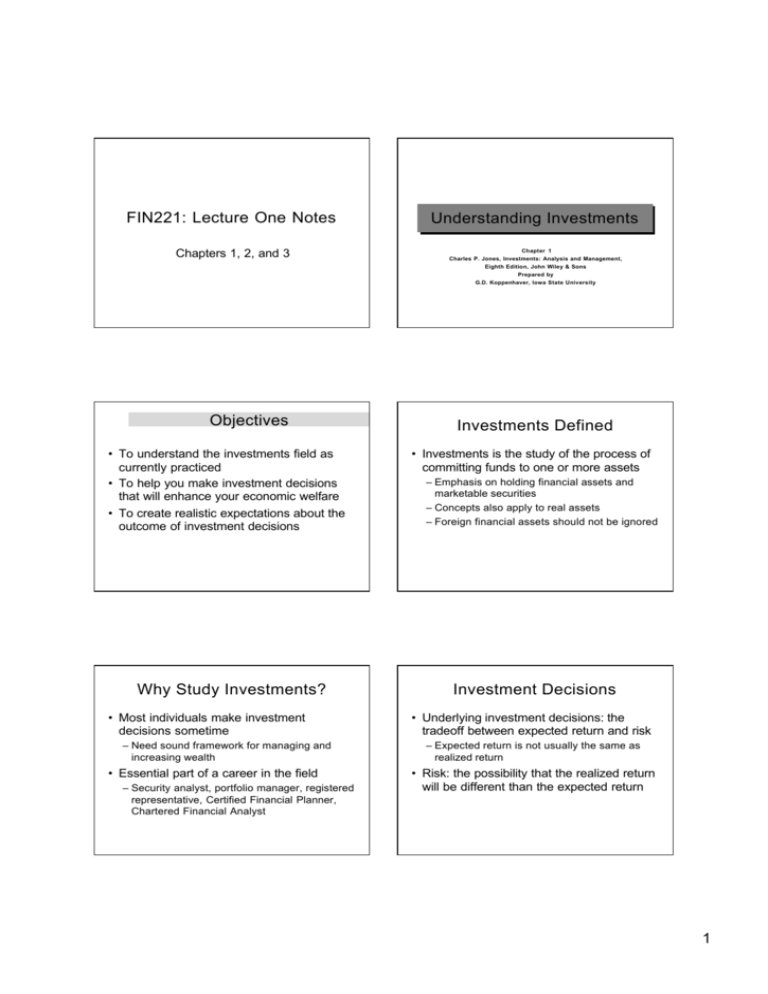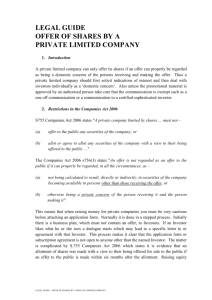
FIN221: Lecture One Notes
Understanding Investments
Chapters 1, 2, and 3
Chapter 1
Charles P. Jones, Investments: Analysis and Management,
Eighth Edition, John Wiley & Sons
Prepared by
G.D. Koppenhaver, Iowa State University
Objectives
• To understand the investments field as
currently practiced
• To help you make investment decisions
that will enhance your economic welfare
• To create realistic expectations about the
outcome of investment decisions
Why Study Investments?
• Most individuals make investment
decisions sometime
– Need sound framework for managing and
increasing wealth
• Essential part of a career in the field
– Security analyst, portfolio manager, registered
representative, Certified Financial Planner,
Chartered Financial Analyst
Investments Defined
• Investments is the study of the process of
committing funds to one or more assets
– Emphasis on holding financial assets and
marketable securities
– Concepts also apply to real assets
– Foreign financial assets should not be ignored
Investment Decisions
• Underlying investment decisions: the
tradeoff between expected return and risk
– Expected return is not usually the same as
realized return
• Risk: the possibility that the realized return
will be different than the expected return
1
The Tradeoff
Between ER and Risk
• Investors manage
risk at a cost lower expected
returns (ER)
• Any level of
expected return
and risk can be
attained
The Investment Decision
Process
• Two-step process:
– Security analysis and valuation
Stocks
ER
• Necessary to understand security characteristics
– Portfolio management
Bonds
• Selected securities viewed as a single unit
• How and when should it be revised?
• How should portfolio performance be measured?
Risk-free Rate
Risk
Factors Affecting the Process
• Uncertainty in ex post returns dominates
decision process
– Future unknown and must be estimated
• Foreign financial assets: opportunity to
enhance return or reduce risk
• Institutional investors important
• How efficient are financial markets in
processing new information?
Copyright © 2002 John Wiley & Sons, Inc. All rights reserved.
Reproduction or translation of this work beyond that permitted
in Section 117 of the 1976 United States Copyright Act
without the express written permission of the copyright owner
is unlawful. Request for further information should be
addressed to the Permissions Department, John Wiley &
Sons, Inc. The purchaser may make back-up copies for
his/her own use only and not for distribution or resale. The
Publisher assumes no responsibility for errors, omissions, or
damages, caused by use of these programs or from the use
of the information contained herein.
The Rise of the Internet
• Revolutionized the flow of investment
information
• Dramatically lowered commission rates for
individual investors
CHAPTER 2
INVESTMENT ALTERNATIVES
2
ORGANIZATION
• DIRECT INVESTING
• INDIRECT
INVESTING
• Debt Securities
• Equity Securities
• Other Securities
• Investment
Companies
– Mutual Funds
– Closed-end Funds
– Unit Investment Trusts
MONEY MARKET SECURITIES
•
•
•
•
•
•
Treasury Bills
Negotiable Certificates of Deposit
Commercial Paper
Repurchase Agreements
Bankers’ Acceptances
others
• Exchange- Traded
Funds ( ETFs)
DEBT SECURITIES
• Money Market
–
–
–
–
short maturities
high quality
large denominations
pays current going
rates for short-term
securities
• Capital Markets
– maturities greater than
one year
– range of quality as
measured by bond
ratings
– various characteristics
as to callability, tax
status, retirement of
debt, secured or not
TYPES OF BONDS
• Federal government
• Government
Agencies
• Municipals
• Corporates
ASSET-BACKED SECURITIES
• Securitization--the transformation of
illiquid, risky individual loans into more
liquid, less risky securites produces AssetBacked Securities
• Many different types of loans have been
transformed--mortgages, credit card
receivables, boat receivables, etc.
• higher risk, higher return
• Default free
• some part of
government, some
not
• generally exempt
from federal taxes
• need taxable
equivalent yield
• are rated by rating
agencies
EQUITY SECURITIES
• Equity securities represent ownership,
while debt securities are creditor
instruments
• Two types of equity securities
– common stock--the basic ownership of the
corporation
– preferred stock--technically an equity security;
it has no maturity debt although it may be
retired by call, convertibility, etc.
3
PREFERRED STOCK
• Hybrid Security
– like common stock, has no maturity date
– like a bond, pays a fixed dividend
• Relatively small supply--therefore,
relatively unimportant
• Dividends on the preferred are not
deductible for the corporation
• Most investors treat it as a substitute for
bonds
COMMON STOCKHOLDERS
• Stockholders can benefit directly from a
common stock in only two ways:
– dividends--the cash payments of the
corporation. A firm has no obligation.
Dividends can be raised, lowered, or
suspended
– price change--the difference between
purchase price and sale price. This can be +,
-, or 0
– therefore, stock returns can be positive,
negative or zero
IMPORTANT TERMS WITH
STOCKS
• Dividend Yield--annual dividend divided by
current stock price
• Payout Ratio--the ratio of dividends to
earnings (the percentage of earnings paid
out as dividends)
• P/E Ratio--the number of times earnings
that investors are willing to pay for a stock,
used in valuation of stocks
COMMON STOCK
• Represents the ownership of the
corporation
• Stockholders are the residual claimant-they get what is left after the bondholders
and preferred stockholders have been
paid
• Therefore, payoffs can be large or small
• Risk is large because of the uncertain
payoffs
A NOTE ON DIVIDENDS
• Dividend yield (dividend divided by price)
is one of the two components of Total
Return for stockholders
• Dividend yield on the S&P 500 is at an alltime low (1870-2000) of about 1.4%
• If the dividend yield remains this low, and
stockholders expect to receive the same
Total Returns, how can this happen?
OTHER SECURITIES
• Derivative Securities derive their value
from their connected underlying securities
– Options--typically, puts and calls; the right but
not the obligation to buy or sell an asset
– Futures Contracts--available for financial
assets; carry an obligation to act, but can be
offset by taking the opposite position
4
PUTS AND CALLS
• Call--the right to buy 100 shares of an
asset at a stated price within a stated time
• Put--the right to sell 100 shares of an
asset at a stated price within a stated time
• These options have short maturities of up
to a few months--therefore, they are
wasting assets
• LEAPs have longer maturities, up to three
years
FUTURES CONTRACTS
• Available on commodities and on financial
assets
• They are agreements providing for the
future exchange of a particular asset
between buyer and seller
• Margin must be put up to ensure
performance--a small percentage of the
value of the contract
PUTS AND CALLS
• Puts and Calls are bought by investors
who think prices will move in a certain
direction, and are sold by investors with
opposite beliefs
• The premium is paid by the buyer, and
received by the seller. Both pay
brokerage costs
• Options trade on organized exchanges
FUTURES CONTRACTS
• Are standarized and trade on organized
exchanges
• Most are not exercised--they are “offset”
by taking the opposite position
• Most participants are either hedgers or
speculators
– hedging--seek to reduce price uncertainty
– speculate--seek to profit from the uncertainty
HOUSEHOLDS
• Households have opted more and more
for indirect investing
CHAPTER 3
INVESTMENT COMPANIES
– in pension fund assets
– in investment companies, primarily mutual
funds
• Indirect investing involves turning one’s
funds over to an intermediary to invest
• Investors can invest directly, invest
indirectly, or do a combination
5
INVESTMENT COMPANIES
• Definition--a financial services
organization that sells shares in itself and
uses the funds to invest in a portfolio of
securites
• Three types:
– open-end investment companies --mutual
funds
– closed-end investment companies
– unit investment trusts
CLOSED-END INVESTMENT
COMPANIES
• Trade on Exchanges like other stocks
• Are relatively few in number, with relatively
small total assets
• Include various types of equity and bond
funds
• Almost always sell at discounts and
premiums rather than at NAV per share
MUTUAL FUNDS
MAJOR TYPES OF MUTUAL
FUNDS
• Technically, mutual funds are open-end
investment companies because the
number of its own shares outstanding is
constantly changing
• Investors buy from and sell back to the
investment company itself
• As of August, 2001 there were about 8300
mutual funds in the United States
• Money Market Funds--invest in money
market securities such as Treasury bills,
commercial paper, and negotiable CDs
• Equity and Bond & Income Funds--invest
in portfolios of stocks or bonds, or in the
case of balanced funds, both. There are
various types of stock funds as well as
bond funds (short or long-term, taxable or
not)
NET ASSET VALUE
SALES CHARGES
• Each investment company has a Net
Asset Value (NAV) per share
• It is calculated as the value of the
securities in the portfolio, less any
liabilities, divided by the number of shares
of the fund outstanding
• Therefore, it is the per share value of the
portfolio of securities
NO-LOAD
LOW LOAD
LOAD
no sales
charge
low sales
charge, such
as 2-3%
sales charge
currently,
maximum of 5
to 6%
6
ADDITIONAL COSTS
SHARE CLASSES
• The load fee is the sales charge, primarily
used to compensate the sales force
• The fund may charge a 12b-1 fee, as
much as 1% of assets annually, to cover
distribution costs
• Class B and Class C shares can carry a
redemption fee
• Many funds have at least three classes of
shares, referred to as A, B and C
• A shares are the “norm,” carrying a load fee
• B shares carry no load, but have a redemption
charge that declines over 5 or 6 years for
investors redeeming shares early
• C shares have a redemption charge for one year
but an annual 12b-1 fee of maybe 1%
OPERATING EXPENSE RATIO
MEASURING FUND
PERFORMANCE
• Unless waived for marketing reasons, all
funds charge an annual operating expense
for managing the fund.
• This cost is calculated as a percentage of
average assets under management
• The average for equity funds is about
1.4%, for bond funds perhaps 1%, and for
money market funds less than 1%
• Cumulative Total Return measures the
actual cumulative performance over some
period of time, such as 3, 5 or 10 years
• Average Annual Return is the compound
rate that if achieved annually would have
produced the same cumulative total return
(this is a compound annual return, not the
actual returns of the fund each year)
INDEX FUNDS
FUND PERFORMANCE
• Index Funds are designed to replicate
some market index or benchmark, with no
active management
• Costs are very low because no research
or active management is needed
• Vanguard’s Index 500 fund is now the
largest mutual fund in the United States
• Fund performance has been often debated
as to consistency and actual results
• Many comparisons indicate that a majority
of mutual funds do not outperform the
proper benchmark such as the S&P 500
• Given an annual average expense ratio of
1.4%, equity funds must earn more than
that plus the benchmark return to add
value
7
INVESTING
INTERNATIONALLY
• International funds concentrate primarily
on international stocks
• Global funds keep a significant portion of
assets in U. S. stocks
• Single-country funds concentrate on the
securities of a single country
• Investing internationally exposes investors
to currency risk (exchange-rate risk)
FUND SUPERMARKETS
• Some large brokerage firms like Schwab
and Fidelity offer fund “supermarkets.”
• Investors can buy a variety of funds
through their brokerage accounts,
meaning they do it all in one account.
8








